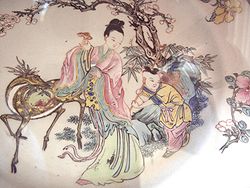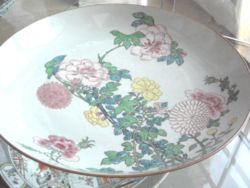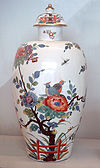- Dresden Porcelain Collection
-
The Dresden Porcelain Collection (German: Porzellansammlung) is part of the Staatliche Kunstsammlungen (State Art Collections) of Dresden, Germany. It is located in the Zwinger Palace.
Contents
History and description
The collection was founded in 1715 by the Saxon Prince-Elector Augustus the Strong, and was originally housed in the Japanese Palace (then known as the "Dutch Palace") on the banks of the Elbe. It moved into the Johanneum in 1876. The collection largely survived World War II thanks to evacuation, and moved into its current home in the south part of the Zwinger in 1962. Today the collection features 20,000 porcelain artefacts.[1]
One strength is the collection of traditional Chinese and Japanese porcelain acquired by Augustus the Strong. Above all this includes blue-and-white porcelain from the Ming and Qing Dynasties, in particular the "Dragoon Vases" acquired by Augustus from King Frederick William I in exchange for a regiment of dragoons. There are also colourful famille-verte and famille-rose items, white Dehua ceramics, Japanese Arita porcelain, and ceramics made especially for export.
The other strongpoint is the collection of Saxon porcelain, in particular Meissen porcelain. This crockery is decorated partly with Chinese patterns, but also with various European motifs such as scenes from mythology or rococo idylls. There are also numerous sculptures made of pure white or painted porcelain, including miniature comedians, musicians and court jesters (Schmiedel and Fröhlich), a table set created for King Frederick Augustus III, and a tableau of riders belonging to King Augustus III.
Due to lack of space, not all the items are on permanent display.[1] A new gallery for the East Asian collection was opened in 2006,[2] increasing the exhibition space by a quarter. It was created in a matter of months by the New York architect Peter Marino with a mixture of classical and modern elements. In the modern section, Japanese blue-and-white porcelain is presented on historic tables, in front of panels lacquered with anthracite grey and cinnabar. Marino carried out further redesigns in 2010.[3][4]
Further reading
- Anette Loesch, Ulrich Pietsch, Friedrich Reichel: Porzellansammlung Dresden - Führer durch die Ständige Ausstellung. Dresden, 1998, ISBN 3932264053. (German)
- Ingelore Menzhausen: Alt-Meißner Porzellan in Dresden. Berlin, 1988, ISBN 3362001424. (German)
References
- ^ a b Sommerkultur: Pomp und Pracht Herien Wensink, Der Tagesspiegel, 14 May 2010. Retrieved 30 April 2011. (German)
- ^ Porcelain pieces fill museums in Dresden, Germany John Fleming, St. Petersburg Times, 16 August 2009. Retrieved 13 September 2010. (English)
- ^ Triumph of the Blue Swords. Meissen Porcelain® for Aristocracy and Bourgeoisie 1710 - 1815 Staatliche Kunstsammlungen Dresden, 17 May 2010. Retrieved 30 April 2011. (English)
- ^ Porzellansammlung im Dresdner Zwinger neu inszeniert City of Dresden, 1 April 2010. Retrieved 30 April 2011. (German)
External links
- Porzellansammlung (Porcelain Collection) at Staatliche Kunstsammlungen Dresden
- Porzellansammlung - Information and history from the Dresden and Saxony tourist website (German)
- This article incorporates information from this version of the equivalent article on the German Wikipedia.
Coordinates: 51°03′08″N 13°44′05″E / 51.05222°N 13.73472°E
Porcelain China Chinese porcelain · Chinese export porcelain · Chinese influences on Islamic pottery
Types: Proto-celadon (16th century BCE) · Celadon (1st century) · Yue (2nd century) · Jingdezhen (6th century) · Sancai (8th century) · Ding (10th century) · Qingbai (12th century) · Blue and white (14th century) · Blanc de Chine (14th century) · Kraak (16th century) · Swatow (16th century) · Kangxi (17th century) · Famille jaune, noire, rose, verte (17th century) · Tenkei (17th century) · Canton (18th century)Korea Types: Joseon (14th century)Japan Europe French porcelain · Chinese porcelain in European painting
Types: Fonthill Vase (1338) · Medici (1575) · Rouen (1673) · Nevers · Saint-Cloud (1693) · Meissen (1710) · Chantilly (1730) · Vincennes (1740) · Chelsea (1743) · Oranienbaum (1744) · Mennecy (1745) · Bow (1747) · Nymphenburg Porcelain Manufactory (1747) · Plymouth (1748) · Worcester (1751) · Frankenthal Porcelain Factory (1755) · Sèvres (1756) · Derby (1757) · Wedgwood (1759) · Wallendorf (1764) · Etiolles (1770) · Limoges (1771) · Clignancourt (1775) · Royal Copenhagen (1775) · Revol (1789) · Herend Porcelain Manufactory (1826) · Zsolnay (1853)Technologies People Ehrenfried Walther von Tschirnhaus · Johann Friedrich Böttger · Francois Xavier d'Entrecolles · Dmitry VinogradovCollections British Museum (London): Asia Department / Percival David Foundation · Dresden Porcelain Collection · Gardiner Museum (Toronto) · Kuskovo State Museum of Ceramics (Moscow) · Musée national de Céramique-Sèvres (Paris) · Musée des Arts Décoratifs (Paris) · Palace Museum (Beijing) · Topkapı Palace (Istanbul) · Victoria and Albert Museum (London) · Worcester Porcelain MuseumCategories:- 1715 establishments
- Collections of museums in Germany
- Ceramics museums
- Art museums and galleries in Dresden
- Decorative arts museums in Germany
- Porcelain
Wikimedia Foundation. 2010.





